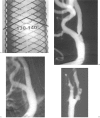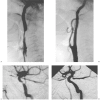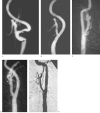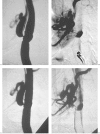"Protected" wallstenting of atheromatous stenoses at the carotid bifurcation
- PMID: 20591262
- PMCID: PMC3547516
- DOI: 10.1177/159101990300900201
"Protected" wallstenting of atheromatous stenoses at the carotid bifurcation
Erratum in
-
Errata corrige: int. Neur. 9: 99-126:"protected" wallstenting of atheromatous stenoses at the carotid bifurcation.Interv Neuroradiol. 2003 Sep 30;9(3):323-4. Epub 2004 Oct 22. Interv Neuroradiol. 2003. PMID: 20591261 Free PMC article. No abstract available.
Abstract
Atheromatous stenoses at the carotid bifurcation were treated by angioplasty and Wallstenting with cerebral protection obtained in most cases by temporary occlusion of the internal carotid artery. 287 carotid stenoses were treated in 233 patients. The stenosis was symptomatic in 79% of cases. All patients presented either a stenosis of >70% with significant impairment of the cerebral circulation (281 cases) or a symptomatic ulcerated plaque (six cases). A self-mounted protection system was used in 177 cases, the Percusurge Guardwire protection device in 98 cases an EPI filter in 12 cases. There was a contralateral internal carotid occlusion in 13% of cases. A combined stenting (vertebral, siphon, subclavian) was performed in 14% of cases. A Rolling membrane Wallstent was used in 84 patients, a first generation Easy Wallstent in 38 cases, a "Carotid" Easy Wallstent 35 in 55 cases and monorail 14 in 110 cases. Full opening of the stenosis was obtained in 98% of patients with correction of the arterial curve and improvement of the cerebral vascular supply. There were 0.7% cases with transient symptomatic neurological complications and 2% with permanent sequelae mainly related to avoidable inadequacy in flushing or to the insufficient radial force of the first generation Easy Wallstent. There were no per and one post-procedural cardiac complication (0.6%) in the s165 cases performed with the "Carotid" Easy Wallstent. Follow-up angiograms showed 0.7% of restenoses. Still in evolution, endovascular treatment of atheromatous stenoses at the carotid bifurcation with cerebral protection and stenting is a promising alternative technique to surgery. The association of Carotid Easy Wallstent 14 monorail and Percusurge Guardwire appears to be currently satisfactory.
Figures





















Similar articles
-
Stenting of atherosclerotic stenoses of the extracranial carotid artery.Acta Neurochir (Wien). 2001 Oct;143(10):1005-11. doi: 10.1007/s007010170005. Acta Neurochir (Wien). 2001. PMID: 11685607
-
[Endovascular treatment of carotid stenosis].Radiol Med. 2001 May;101(5):348-54. Radiol Med. 2001. PMID: 11438786 Italian.
-
Carotid angioplasty under cerebral protection with the PercuSurge GuardWire System.Catheter Cardiovasc Interv. 2004 Mar;61(3):293-305. doi: 10.1002/ccd.10776. Catheter Cardiovasc Interv. 2004. PMID: 14988883
-
Carotid angioplasty and stenting under cerebral protection with the Percusurge Guardwire system.J Interv Cardiol. 2004 Aug;17(4):233-43. doi: 10.1111/j.1540-8183.2004.00394.x. J Interv Cardiol. 2004. PMID: 15318895 Review. No abstract available.
-
A meta-analysis of combined endarterectomy and proximal balloon angioplasty for tandem disease of the arch vessels and carotid bifurcation.J Vasc Surg. 2011 Aug;54(2):534-40. doi: 10.1016/j.jvs.2011.04.022. J Vasc Surg. 2011. PMID: 21684709 Review.
Cited by
-
Radial approach in the treatment of supraaortic arterial lesions.Interv Neuroradiol. 2007 Jun;13(2):133-44. doi: 10.1177/159101990701300203. Epub 2007 Sep 13. Interv Neuroradiol. 2007. PMID: 20566141 Free PMC article.
References
-
- Dotter CT, Judkins MP. Transluminal treatment of arteriosclerotic obstruction: description of a new technique and a preliminary report of its applications. Circulation. 1964;30:654–670. - PubMed
-
- Grüntzig A, Hopf H. Perkutane Rekanalisation chronischer arterieller Verschlüsse mit einem neuen Katheter: Modifikation der Dotter-technik. Deutsch Med Wochenschr. 1974;99:2502–2505. - PubMed
-
- Mathias K. Perkutane transluminale Katheterbe-handlung supraaortaler Arterienobstruktionen. Angiology. 1981;3:47–50.
LinkOut - more resources
Full Text Sources

